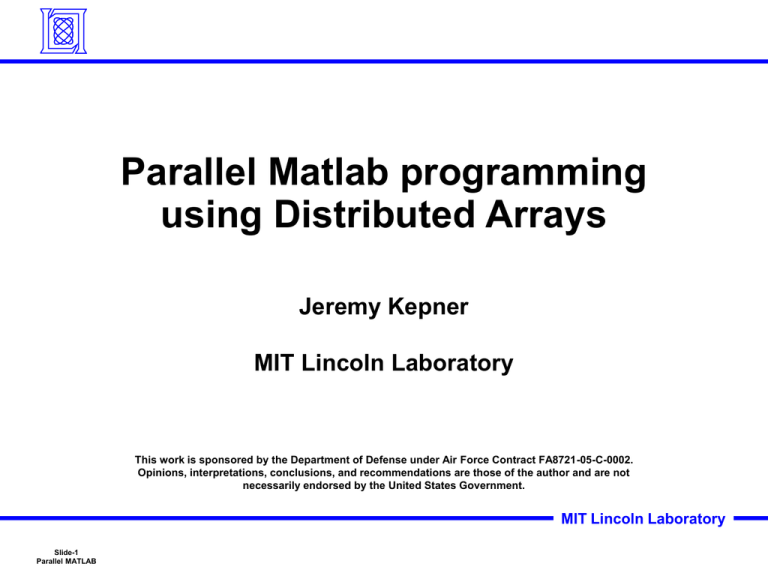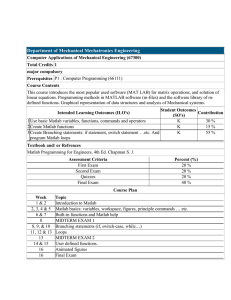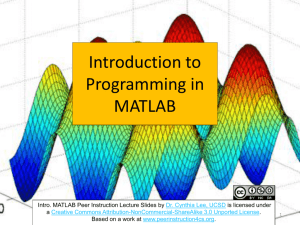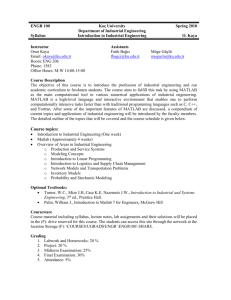300x Matlab - MIT Lincoln Laboratory
advertisement

Parallel Matlab programming
using Distributed Arrays
Jeremy Kepner
MIT Lincoln Laboratory
This work is sponsored by the Department of Defense under Air Force Contract FA8721-05-C-0002.
Opinions, interpretations, conclusions, and recommendations are those of the author and are not
necessarily endorsed by the United States Government.
MIT Lincoln Laboratory
Slide-1
Parallel MATLAB
Goal: Think Matrices not Messages
• In the past, writing well performing parallel programs has
•
required a lot of code and a lot of expertise
pMatlab distributed arrays eliminates the coding burden
– However, making programs run fast still requires expertise
• This talk illustrates the key math concepts experts use to
Performance Speedup
make parallel programs perform well
hardware limit
100
Expert
acceptable
10
Novice
1
0.1
hours
Slide-2
Parallel MATLAB
days
weeks
Programmer Effort
months
MIT Lincoln Laboratory
Outline
• Parallel Design
• Distributed Arrays
•
•
•
•
Serial Program
Parallel Execution
Distributed Arrays
Explicitly Local
• Concurrency vs Locality
• Execution
• Summary
Slide-3
Parallel MATLAB
MIT Lincoln Laboratory
Serial Program
Math
X,Y :
NxN
Y=X+1
Matlab
X = zeros(N,N);
Y = zeros(N,N);
Y(:,:) = X + 1;
• Matlab is a high level language
• Allows mathematical expressions to be written concisely
• Multi-dimensional arrays are fundamental to Matlab
Slide-4
Parallel MATLAB
MIT Lincoln Laboratory
Parallel Execution
Math
pMatlab
Pid=Np-1
PID=NP-1
Pid=1
Pid=0
PID=1
PID=0
X,Y :
NxN
Y=X+1
X = zeros(N,N);
Y = zeros(N,N);
Y(:,:) = X + 1;
• Run NP (or Np) copies of same program
– Single Program Multiple Data (SPMD)
• Each copy has a unique PID (or Pid)
• Every array is replicated on each copy of the program
Slide-5
Parallel MATLAB
MIT Lincoln Laboratory
Distributed Array Program
Math
pMatlab
Pid=Np-1
PID=NP-1
PID=1
PID=0
P(N)xN
X,Y :
Y=X+1
Pid=1
Pid=0
XYmap = map([Np N1],{},0:Np-1);
X = zeros(N,N,XYmap);
Y = zeros(N,N,XYap);
Y(:,:) = X + 1;
• Use P() notation (or map) to make a distributed array
• Tells program which dimension to distribute data
• Each program implicitly operates on only its own data
(owner computes rule)
Slide-6
Parallel MATLAB
MIT Lincoln Laboratory
Explicitly Local Program
Math
P(N)xN
X,Y :
Y.loc = X.loc + 1
pMatlab
XYmap = map([Np 1],{},0:Np-1);
Xloc = local(zeros(N,N,XYmap));
Yloc = local(zeros(N,N,XYmap));
Yloc(:,:) = Xloc + 1;
• Use .loc notation (or local function) to explicitly retrieve
•
local part of a distributed array
Operation is the same as serial program, but with different
data on each processor (recommended approach)
Slide-7
Parallel MATLAB
MIT Lincoln Laboratory
Outline
• Parallel Design
• Distributed Arrays
• Maps
• Redistribution
• Concurrency vs Locality
• Execution
• Summary
Slide-8
Parallel MATLAB
MIT Lincoln Laboratory
Parallel Data Maps
Array
Math
Matlab
P(N)xN
Xmap=map([Np 1],{},0:Np-1)
NxP(N)
Xmap=map([1 Np],{},0:Np-1)
P(N)xP(N)
Xmap=map([Np/2 2],{},0:Np-1)
Computer
PID 0 1 2 3 Pid
• A map is a mapping of array indices to processors
• Can be block, cyclic, block-cyclic, or block w/overlap
• Use P() notation (or map) to set which dimension to split
among processors
Slide-9
Parallel MATLAB
MIT Lincoln Laboratory
Maps and Distributed Arrays
A processor map for a numerical array is an assignment of
blocks of data to processing elements.
Amap = map([Np 1],{},0:Np-1);
Processor Grid
List of processors
Distribution
{}=default=block
A = zeros(4,6,Amap);
P0
P1
P2
P3
Slide-10
Parallel MATLAB
pMatlab constructors are overloaded to
take a map as an argument, and return a
distributed array.
A =
000000
000000
000000
000000
MIT Lincoln Laboratory
Advantages of Maps
Maps are scalable. Changing the
number of processors or distribution
does not change the application.
MAP1
%Application
A=rand(M,map<i>);
B=fft(A);
MAP2
map1=map([Np 1],{},0:Np-1)
map2=map([1 Np],{},0:Np-1)
Matrix Multiply
Maps support different algorithms.
Different parallel algorithms have
different optimal mappings.
*
map([2 2],{},0:3)
map([2 2],{},0)
Slide-11
Parallel MATLAB
map([2 2],{},3)
foo3
foo2
foo1
map([2 2],{},1)
foo4
map([2 2],{},[0 2 1 3])
Maps allow users to set up pipelines
in the code (implicit task parallelism).
FFT along
columns
map([2 2],{},2)
MIT Lincoln Laboratory
Redistribution of Data
Math
X : P(N)xN
Y : NxP(N)
Y=X+1
pMatlab
Xmap = map([Np 1],{},0:Np-1);
Ymap = map([1 Np],{},0:Np-1);
X = zeros(N,N,Xmap);
Y = zeros(N,N,Ymap);
Y(:,:) = X + 1;
X =
P0
P1
P2
P3
Y =
Data Sent
P0 P1 P2 P3
• Different distributed arrays can have different maps
• Assignment between arrays with the “=” operator causes
•
data to be redistributed
Underlying library determines all the message to send
Slide-12
Parallel MATLAB
MIT Lincoln Laboratory
Outline
• Parallel Design
• Distributed Arrays
• Concurrency vs Locality
• Execution
• Definition
• Example
• Metrics
• Summary
Slide-13
Parallel MATLAB
MIT Lincoln Laboratory
Definitions
Parallel Concurrency
• Number of operations that can be
done in parallel (i.e. no
dependencies)
• Measured with:
Degrees of Parallelism
Parallel Locality
• Is the data for the operations
local to the processor
• Measured with ratio:
Computation/Communication
= (Work)/(Data Moved)
• Concurrency is ubiquitous; “easy” to find
• Locality is harder to find, but is the key to performance
• Distributed arrays derive concurrency from locality
Slide-14
Parallel MATLAB
MIT Lincoln Laboratory
Serial
Math
X,Y :
NxN
for i=1:N
for j=1:N
Y(i,j) = X(i,j) + 1
Matlab
X = zeros(N,N);
Y = zeros(N,N);
for i=1:N
for j=1:N
Y(i,j) = X(i,j) + 1;
end
end
• Concurrency: max degrees of parallelism = N2
• Locality
–
–
Slide-15
Parallel MATLAB
Work = N2
Data Moved: depends upon map
MIT Lincoln Laboratory
1D distribution
Math
X,Y :
P(N)xN
for i=1:N
for j=1:N
Y(i,j) = X(i,j) + 1
pMatlab
XYmap = map([NP 1],{},0:Np-1);
X = zeros(N,N,XYmap);
Y = zeros(N,N,XYmap);
for i=1:N
for j=1:N
Y(i,j) = X(i,j) + 1;
end
end
• Concurrency: degrees of parallelism = min(N,NP)
• Locality: Work = N2, Data Moved = 0
• Computation/Communication = Work/(Data Moved)
Slide-16
Parallel MATLAB
MIT Lincoln Laboratory
2D distribution
Math
X,Y :
P(N)xP(N)
for i=1:N
for j=1:N
Y(i,j) = X(i,j) + 1
pMatlab
XYmap = map([Np/2 2],{},0:Np-1);
X = zeros(N,N,XYmap);
Y = zeros(N,N,XYmap);
for i=1:N
for j=1:N
Y(i,j) = X(i,j) + 1;
end
end
• Concurrency: degrees of parallelism = min(N2,NP)
• Locality: Work = N2, Data Moved = 0
• Computation/Communication = Work/(Data Moved)
Slide-17
Parallel MATLAB
MIT Lincoln Laboratory
2D Explicitly Local
Math
X,Y :
P(N)xP(N)
for i=1:size(X.loc,1)
for j=1:size(X.loc,2)
Y.loc(i,j) =
X.loc(i,j) + 1
pMatlab
XYmap = map([Np/2 2],{},0:Np-1);
Xloc = local(zeros(N,N,XYmap));
Yloc = local(zeros(N,N,XYmap));
for i=1:size(Xloc,1)
for j=1:size(Xloc,2)
Yloc(i,j) = Xloc(i,j) + 1;
end
end
• Concurrency: degrees of parallelism = min(N2,NP)
• Locality: Work = N2, Data Moved = 0
• Computation/Communication = Work/(Data Moved)
Slide-18
Parallel MATLAB
MIT Lincoln Laboratory
1D with Redistribution
Math
X
Y
:
:
P(N)xN
NxP(N)
for i=1:N
for j=1:N
Y(i,j) = X(i,j) + 1
pMatlab
Xmap = map([Np 1],{},0:Np-1);
Ymap = map([1 Np],{},0:Np-1);
X = zeros(N,N,Xmap);
Y = zeros(N,N,Ymap);
for i=1:N
for j=1:N
Y(i,j) = X(i,j) + 1;
end
end
• Concurrency: degrees of parallelism = min(N,NP)
• Locality: Work = N2, Data Moved = N2
• Computation/Communication = Work/(Data Moved) = 1
Slide-19
Parallel MATLAB
MIT Lincoln Laboratory
Outline
• Parallel Design
• Distributed Arrays
• Concurrency vs Locality
• Execution
• Summary
Slide-20
Parallel MATLAB
•
•
•
•
•
Four Step Process
Speedup
Amdahl’s Law
Perforfmance vs Effort
Portability
MIT Lincoln Laboratory
Running
• Start Matlab
– Type:
cd examples/AddOne
• Run dAddOne
– Edit pAddOne.m and set: PARALLEL = 0;
– Type:
pRUN(’pAddOne’,1,{})
• Repeat with:
PARALLEL = 1;
• Repeat with:
pRUN(’pAddOne’,2,{});
• Repeat with:
pRUN(’pAddOne’,2,{’cluster’});
• Four steps to taking a serial Matlab program and making it
a parallel Matlab program
Slide-21
Parallel MATLAB
MIT Lincoln Laboratory
Parallel Debugging Processes
• Simple four step process for debugging a parallel program
Serial
Matlab
Add distributed matrices without maps, verify functional
correctness
PARALLEL=0;
pRUN(’pAddOne’,1,{});
Step 1
Add DMATs
Serial
pMatlab
Functional
correctness
Add maps, run on 1 processor, verify parallel correctness,
compare performance with Step 1
PARALLEL=1;
pRUN(’pAddOne’,1,{});
Step 2
Add Maps
Mapped
pMatlab
pMatlab
correctness
Run with more processes, verify parallel correctness
PARALLEL=1;
pRUN(’pAddOne’,2,{}) );
Step 3
Add Matlabs
Parallel
pMatlab
Step 4
Add CPUs
Optimized
pMatlab
Parallel
correctness
Run with more processors, compare performance with Step 2
PARALLEL=1;
pRUN(’pAddOne’,2,{‘cluster’});
Performance
• Always debug at earliest step possible (takes less time)
Slide-22
Parallel MATLAB
MIT Lincoln Laboratory
Timing
• Run dAddOne:
pRUN(’pAddOne’,1,{’cluster’});
– Record processing_time
• Repeat with:
pRUN(’pAddOne’,2,{’cluster’});
– Record processing_time
• Repeat with:
pRUN(’pAddone’,4,{’cluster’});
– Record processing_time
• Repeat with:
pRUN(’pAddone’,8,{’cluster’});
– Record processing_time
• Repeat with:
pRUN(’pAddone’,16,{’cluster’});
– Record processing_time
• Run program while doubling number of processors
• Record execution time
Slide-23
Parallel MATLAB
MIT Lincoln Laboratory
Computing Speedup
100
Speedup
Linear
Superlinear
Sublinear
Saturation
10
1
1
2
4
8
16
32
64
Number of Processors
• Speedup Formula: Speedup(NP) = Time(NP=1)/Time(NP)
• Goal is sublinear speedup
• All programs saturate at some value of NP
Slide-24
Parallel MATLAB
MIT Lincoln Laboratory
Amdahl’s Law
Smax = w|-1
10
Smax/2
NP = w|-1
Speedup
100
1
1
2
4
8
16
32
64
128
Processors
• Divide work into parallel (w||) and serial (w|) fractions
• Serial fraction sets maximum speedup: Smax = w|-1
• Likewise: Speedup(NP=w|-1) = Smax/2
Slide-25
Parallel MATLAB
MIT Lincoln Laboratory
HPC Challenge Speedup vs Effort
1000
ideal speedup = 128
100
Speedup
10
STREAM
C + MPI
Matlab
pMatlab
STREAM
HPL
FFT
FFT
HPL(32)
1
HPL
FFT
Serial C
STREAM
0.1
0.01
Random
Access
Random
Access
0.001
0.0001
0.001
Random
Access
0.01
0.1
1
10
Relative Code Size
• Ultimate Goal is speedup with minimum effort
• HPC Challenge benchmark data shows that pMatlab can
deliver high performance with a low code size
Slide-26
Parallel MATLAB
MIT Lincoln Laboratory
Portable Parallel Programming
Universal Parallel Matlab programming
Amap = map([Np 1],{},0:Np-1);
Bmap = map([1 Np],{},0:Np-1);
A = rand(M,N,Amap);
B = zeros(M,N,Bmap);
B(:,:) = fft(A);
• pMatlab runs in all parallel Matlab
environments
• Only a few functions are needed
– Np
– Pid
– map
– local
– put_local
– global_index
– agg
– SendMsg/RecvMsg
•
•
Jeremy Kepner
Parallel MATLAB
for Multicore and Multinode Systems
1
2
3
4
Only a small number of distributed array functions are necessary
to write nearly all parallel programs
Restricting programs to a small set of functions allows parallel
programs to run efficiently on the widest range of platforms
Slide-27
Parallel MATLAB
MIT Lincoln Laboratory
Summary
• Distributed arrays eliminate most parallel coding burden
• Writing well performing programs requires expertise
• Experts rely on several key concepts
– Concurrency vs Locality
– Measuring Speedup
– Amdahl’s Law
• Four step process for developing programs
– Minimizes debugging time
– Maximizes performance
Step 1
Serial
MATLAB
Add DMATs
Get It Right
Slide-28
Parallel MATLAB
Step 2
Serial
pMatlab
Functional
correctness
Add Maps
Step 3
Mapped
pMatlab
pMatlab
correctness
Add Matlabs
Step 4
Parallel
pMatlab
Parallel
correctness
Add CPUs
Optimized
pMatlab
Performance
Make It Fast
MIT Lincoln Laboratory






